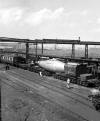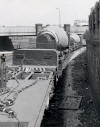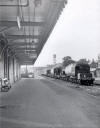


John Donnelly collection



(Thanks to Chris Purdon for identifying the location)


John Donnelly collection
Torpedo wagon tests
|
In 1969, for the first time over an appreciable distance on British Railways, a daily service of trains carrying hot metal was introduced between Tees-side and Northwest Durham. Three specially designed torpedo cars, each carrying a maximum of 80 tons of molten iron, inaugurated a regular 63-mile service between Cargo Fleet Works, Middlesbrough, and Consett Works, Durham, on August 4 1969. The project, planned by the Iron & Steel Division of the Northern & Tubes Group of the British Steel Corporation in co-operation with BR, provided iron needed to maintain steel production whilst blast furnaces were being rebuilt, and ultimately secured full potential output of the basic oxygen steel plant at Consett. Each train comprised two English Electric Type 3 1,750 hp diesel locomotives working in multiple, three torpedo cars and three spacer wagons between the cars to distribute the load over bridges. The torpedo cars were designed and built to BR requirements by the Distington Engineering Co. Ltd. (BSC Midland Group) in association with Demag AG. Each car was carried on 14 axles and weighs approximately 241 tons fully laden. Overall length was 84 ft 8 in. Each vessel was sealed with a special lid and had a 15 in layer of insulation. The outer skin of the vessel was further shielded by steel plate. A test train to assess the riding qualities of the vehicles was to be seen around the Middlesbrough area on 7th August 1969 consisting of two 'torpedo' wagons and associated wagons. I have now added some memories from Robert Carter, who was on these tests and some more photos courtesy John Donnelly who has an interesting site about railways in the North east and includes more photos and information about these trains www.http://southpelaw junction.co.uk Click on the pictures for a bigger image - All photos are from the author's collection except where indicated |
A note from Robert Carter MIET who was on these tests
I was on the torpedo wagon tests in 1969. I remember the tests very well. We used to travel to Darlington, and run a test train about every other day, working 22 hours on the days we ran. It was my job to hook up all the cables before each run, and to disconnect them for the engines to run round at the Middlesbrough end of the run. Very often we were taken back to our digs in Darlington in the back of a British Steel van at 4.00 in the morning. I remember the testing staff on the run, our maintenance man and a few others. I used to ride in the locos to keep the driver in contact with the test crew. One day we were stopped for "train on fire" and I climbed up on top of one of the torpedoes to screw down the lid a bit tighter! I was hailed as a hero by our team. We were the only freight train to get priority over passenger trains due to the urgency to get the steel delivered before it went solid. I was only 25 at the time, but it was an interesting job. |